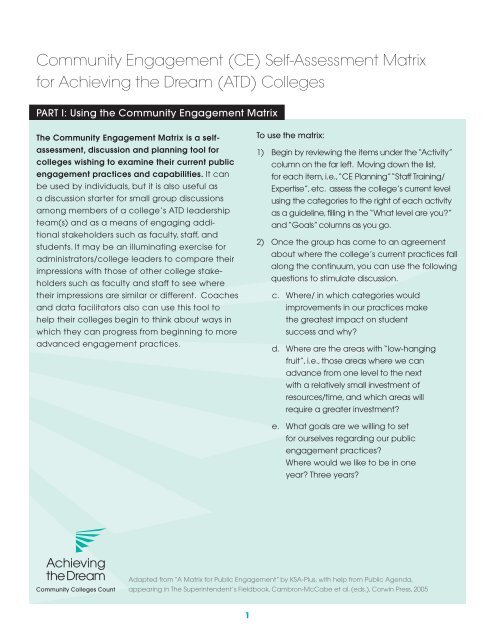Community Engagement (CE) Self-Assessment Matrix
Community Engagement (CE) Self-Assessment Matrix
Community Engagement (CE) Self-Assessment Matrix
You also want an ePaper? Increase the reach of your titles
YUMPU automatically turns print PDFs into web optimized ePapers that Google loves.
<strong>Community</strong> <strong>Engagement</strong> (<strong>CE</strong>) <strong>Self</strong>-<strong>Assessment</strong> <strong>Matrix</strong><br />
for Achieving the Dream (ATD) Colleges<br />
Part I: Using the <strong>Community</strong> <strong>Engagement</strong> <strong>Matrix</strong><br />
The <strong>Community</strong> <strong>Engagement</strong> <strong>Matrix</strong> is a selfassessment,<br />
discussion and planning tool for<br />
colleges wishing to examine their current public<br />
engagement practices and capabilities. It can<br />
be used by individuals, but it is also useful as<br />
a discussion starter for small group discussions<br />
among members of a college’s ATD leadership<br />
team(s) and as a means of engaging additional<br />
stakeholders such as faculty, staff, and<br />
students. It may be an illuminating exercise for<br />
administrators/college leaders to compare their<br />
impressions with those of other college stakeholders<br />
such as faculty and staff to see where<br />
their impressions are similar or different. Coaches<br />
and data facilitators also can use this tool to<br />
help their colleges begin to think about ways in<br />
which they can progress from beginning to more<br />
advanced engagement practices.<br />
To use the matrix:<br />
1) Begin by reviewing the items under the “Activity”<br />
column on the far left. Moving down the list,<br />
for each item, i.e., “<strong>CE</strong> Planning” “Staff Training/<br />
Expertise”, etc. assess the college’s current level<br />
using the categories to the right of each activity<br />
as a guideline, filling in the “What level are you”<br />
and “Goals” columns as you go.<br />
2) Once the group has come to an agreement<br />
about where the college’s current practices fall<br />
along the continuum, you can use the following<br />
questions to stimulate discussion.<br />
c. Where/ in which categories would<br />
improvements in our practices make<br />
the greatest impact on student<br />
success and why<br />
d. Where are the areas with “low-hanging<br />
fruit”, i.e., those areas where we can<br />
advance from one level to the next<br />
with a relatively small investment of<br />
resources/time, and which areas will<br />
require a greater investment<br />
e.<br />
What goals are we willing to set<br />
for ourselves regarding our public<br />
engagement practices<br />
Where would we like to be in one<br />
year Three years<br />
Adapted from “A <strong>Matrix</strong> for Public <strong>Engagement</strong>” by KSA-Plus, with help from Public Agenda,<br />
appearing in The Superintendent’s Fieldbook, Cambron-McCabe et al. (eds.), Corwin Press, 2005<br />
1
<strong>Community</strong> <strong>Engagement</strong> (<strong>CE</strong>) <strong>Self</strong>-<strong>Assessment</strong> <strong>Matrix</strong><br />
Activity Level 1 Level 2 Level 3 Level 4 Which level<br />
are you<br />
Goals<br />
Infrastructure<br />
<strong>CE</strong> Planning Planning to plan Plan focuses<br />
on ad-hoc mix<br />
of messages/<br />
events/materials<br />
Plan is datadriven<br />
& focused<br />
on ATD goals<br />
In addition to 3,<br />
plan is created<br />
with community<br />
input<br />
College Staff<br />
Training and<br />
Expertise<br />
Printed materials<br />
only<br />
Limited customerservice<br />
training<br />
for administrators<br />
and support staff<br />
Broad<br />
communications<br />
training, including<br />
media and<br />
community<br />
engagement<br />
training, for most<br />
staff<br />
In addition to 3,<br />
training has ATD<br />
goals in mind—<br />
closing achieve<br />
gaps, data<br />
based, etc.<br />
<strong>CE</strong> Resoures<br />
(Budgets, staff,<br />
technology)<br />
Resources<br />
appear for<br />
emergency<br />
response only<br />
No regular<br />
budget, parttime<br />
staff; no<br />
website or email<br />
database<br />
Minimal budget,<br />
1-2 full-time staff;<br />
modest website<br />
and email<br />
database<br />
Fully funded<br />
<strong>CE</strong> office/dept,<br />
extensive website<br />
and email<br />
database<br />
College<br />
Leadership<br />
Invovement<br />
President and<br />
senior level<br />
administrators are<br />
minimally aware<br />
of community<br />
engagement<br />
efforts<br />
President/<br />
Administrators<br />
briefed and<br />
received printed<br />
<strong>CE</strong> materials/info<br />
on efforts<br />
President/<br />
Administrators<br />
have provided<br />
staff and<br />
resources to<br />
support college’s<br />
engagement<br />
efforts<br />
President/<br />
Administrators<br />
are actively<br />
engaged and<br />
participate in <strong>CE</strong><br />
meetings and<br />
activities<br />
2
<strong>Community</strong> <strong>Engagement</strong> (<strong>CE</strong>) <strong>Self</strong>-<strong>Assessment</strong> <strong>Matrix</strong><br />
Activity Level 1 Level 2 Level 3 Level 4 Which level<br />
are you<br />
Goals<br />
Basic Practices<br />
Welcoming<br />
Environment<br />
Visitors don’t feel<br />
welcome or know<br />
where to go for<br />
information<br />
Visitors feel<br />
welcome and<br />
know where to<br />
go for information<br />
College<br />
proactively<br />
reaches out to<br />
bring community<br />
onto campus<br />
Customer service<br />
ethic embedded<br />
in staff;<br />
community use of<br />
school increases<br />
Cultural<br />
Awareness/<br />
Sensitivity<br />
President and<br />
Administrators<br />
demonstrate<br />
minimal cultural/<br />
ethnic awareness<br />
College provides<br />
materials and<br />
activities that<br />
reflects staff<br />
and student<br />
diversity through<br />
paintings,<br />
newsletters and<br />
programs<br />
Campus<br />
community feels<br />
satisfaction and<br />
pride about the<br />
level of cultural<br />
awareness and<br />
sensitivity college<br />
demonstrates<br />
<strong>Community</strong> views<br />
the College,<br />
President,<br />
Administrator,<br />
staff and students<br />
as reflective and<br />
understanding of<br />
those they serve<br />
Publications<br />
(This includes<br />
printed and<br />
electronic<br />
materials)<br />
Basic info only<br />
Materials are<br />
reader friendly<br />
and match<br />
readers’ interests<br />
Materials<br />
improved with<br />
community and<br />
student input<br />
Materials speak<br />
to student<br />
achievement;<br />
more<br />
opportunities<br />
for users to<br />
customize<br />
information<br />
(e.g., web)<br />
Media Relations<br />
Priority is damage<br />
control<br />
Ongoing<br />
relationship w/<br />
media is built on<br />
trust<br />
Media efforts<br />
gain coverage<br />
of student<br />
outcomes<br />
and public<br />
engagement<br />
Media helps<br />
promote &<br />
facilitate student<br />
achievement<br />
and public<br />
engagement<br />
3
<strong>Community</strong> <strong>Engagement</strong> (<strong>CE</strong>) <strong>Self</strong>-<strong>Assessment</strong> <strong>Matrix</strong><br />
Activity Level 1 Level 2 Level 3 Level 4 Which level<br />
are you<br />
Goals<br />
Advanced Practices<br />
<strong>Community</strong><br />
Listening/<br />
Research<br />
Listening only<br />
when initiated by<br />
community<br />
Infrequent<br />
efforts to listen<br />
to community<br />
concerns<br />
Regular listening<br />
with mix of tools<br />
(focus groups,<br />
community<br />
conversations,<br />
open houses,<br />
etc.)<br />
Feedback<br />
frequently<br />
sought and<br />
acted upon on<br />
specific initiatives<br />
aimed at ATD<br />
goals<br />
Two-Way<br />
Communications<br />
Communications<br />
mostly one-way.<br />
<strong>Community</strong><br />
rarely hears from<br />
college except<br />
for funding<br />
requests<br />
Minimal attempts<br />
to create<br />
conversations,<br />
mostly with<br />
prospective<br />
students or<br />
“squeaky wheels”<br />
Regular<br />
opportunities<br />
for community<br />
dialogue are<br />
planned,<br />
with effective<br />
outreach<br />
to diverse<br />
audiences—<br />
“beyond usual<br />
suspects”<br />
In addition<br />
to Level 3,<br />
systematic efforts<br />
at dialogue to<br />
develop mutual<br />
understanding<br />
and partnerships<br />
re: improving<br />
student<br />
outcomes.<br />
College-<br />
<strong>Community</strong><br />
Partnerships<br />
No meaningful<br />
partnerships<br />
Limited or<br />
mainly collegecontrolled<br />
partnerships<br />
Partners share<br />
decision making<br />
on common<br />
projects aimed at<br />
achievement<br />
College and<br />
partners hold<br />
each other<br />
accountable for<br />
student success<br />
4
Part II: Goals and Strategies Worksheet<br />
Use this worksheet to elaborate on the goals you identified using the matrix, and as<br />
a place to do some planning for how and when to make progress on those goals.<br />
<strong>Community</strong> <strong>Engagement</strong> Goal Strategies to Achive Goal Action Steps Timeframe & Person/<br />
Department Responsible<br />
NOTE: Additional resources are available to help ATD colleges plan and execute their engagement work, including a Stakeholder<br />
<strong>Engagement</strong> Manual, Campus & <strong>Community</strong> Conversations Organizer’s Planning Guide, Principles and Practices for Student Success Guide:<br />
Faculty <strong>Engagement</strong>, and Planning Workbook for Faculty/Student Dialogues. All materials are located on the ATD web site<br />
(www.AchievingTheDream.org) or from Public Agenda pedept@publicagenda.org.<br />
5






